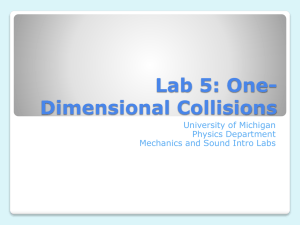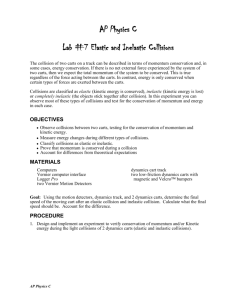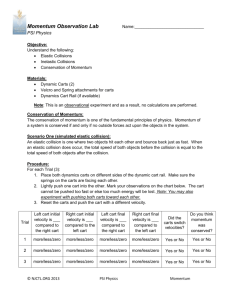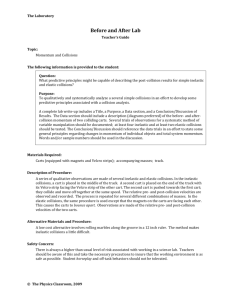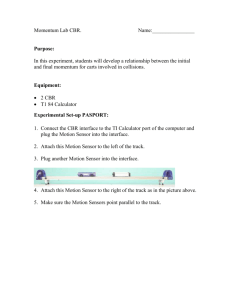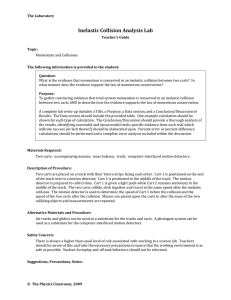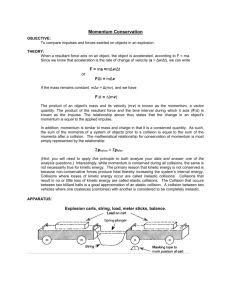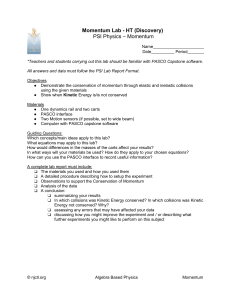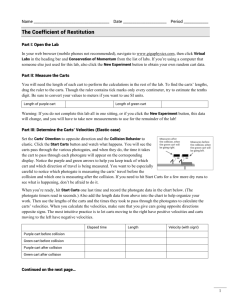MS Word - The Physics Classroom
advertisement
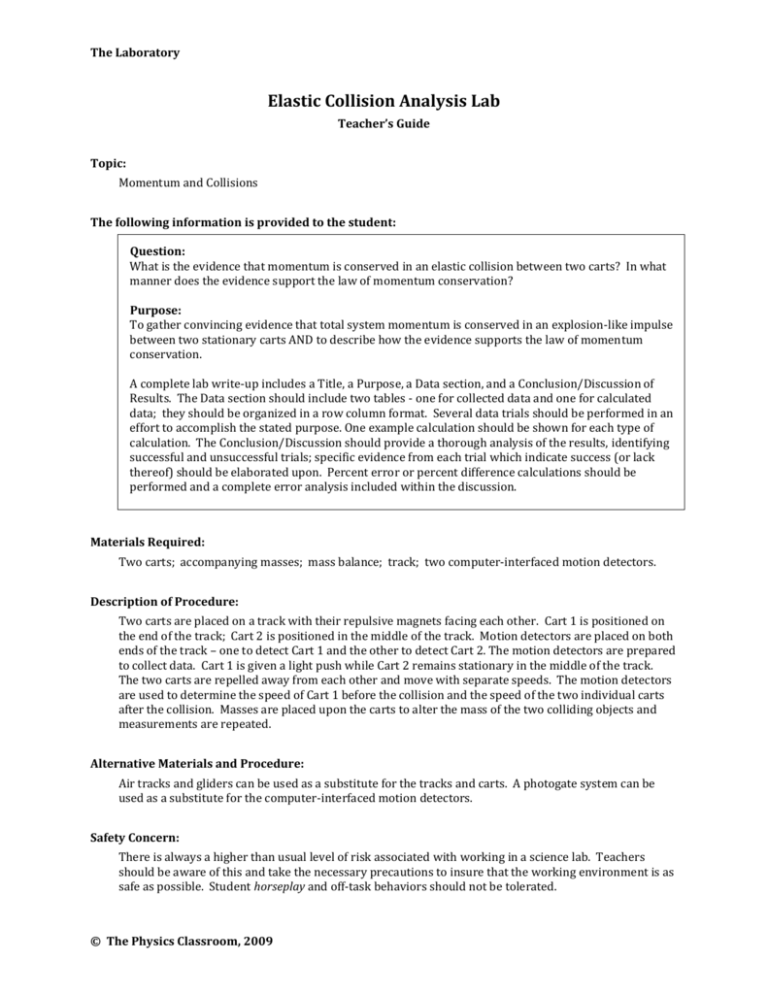
The Laboratory Elastic Collision Analysis Lab Teacher’s Guide Topic: Momentum and Collisions The following information is provided to the student: Question: What is the evidence that momentum is conserved in an elastic collision between two carts? In what manner does the evidence support the law of momentum conservation? Purpose: To gather convincing evidence that total system momentum is conserved in an explosion-like impulse between two stationary carts AND to describe how the evidence supports the law of momentum conservation. A complete lab write-up includes a Title, a Purpose, a Data section, and a Conclusion/Discussion of Results. The Data section should include two tables - one for collected data and one for calculated data; they should be organized in a row column format. Several data trials should be performed in an effort to accomplish the stated purpose. One example calculation should be shown for each type of calculation. The Conclusion/Discussion should provide a thorough analysis of the results, identifying successful and unsuccessful trials; specific evidence from each trial which indicate success (or lack thereof) should be elaborated upon. Percent error or percent difference calculations should be performed and a complete error analysis included within the discussion. Materials Required: Two carts; accompanying masses; mass balance; track; two computer-interfaced motion detectors. Description of Procedure: Two carts are placed on a track with their repulsive magnets facing each other. Cart 1 is positioned on the end of the track; Cart 2 is positioned in the middle of the track. Motion detectors are placed on both ends of the track – one to detect Cart 1 and the other to detect Cart 2. The motion detectors are prepared to collect data. Cart 1 is given a light push while Cart 2 remains stationary in the middle of the track. The two carts are repelled away from each other and move with separate speeds. The motion detectors are used to determine the speed of Cart 1 before the collision and the speed of the two individual carts after the collision. Masses are placed upon the carts to alter the mass of the two colliding objects and measurements are repeated. Alternative Materials and Procedure: Air tracks and gliders can be used as a substitute for the tracks and carts. A photogate system can be used as a substitute for the computer-interfaced motion detectors. Safety Concern: There is always a higher than usual level of risk associated with working in a science lab. Teachers should be aware of this and take the necessary precautions to insure that the working environment is as safe as possible. Student horseplay and off-task behaviors should not be tolerated. © The Physics Classroom, 2009 The Laboratory Suggestions, Precautions, Notes: 1. 2. 3. 4. 5. 6. Pasco Scientific is one of several companies which sells low-friction carts equipped with magnets (for elastic collisions), Velcro strips (for inelastic collisions), plungers (for explosions), additional masses and a mass tray. These are ideal for collision studies and other mechanics labs. Their lowest cost model is ME-6950. To lengthen the lifetime of the carts, remind students to roll the carts at very low speeds. Also remind students that your ears still work and are able to hear carts bouncing off the track and onto the table. Also remind students that you are the one who ultimately assigns them their grade in the course. The acquisition of data from the computer can be difficult. Directions for acquiring data from the computer were provided on a previous lab. Students will have a tendency to give Cart 1 a push and leave their hand above the track, thus interfering with the motion detector’s ability to detect the motion of a cart. Demonstrate for students the proper and improper means of pushing the cart. Attention should be given to the +/- value for velocity (and momentum). A direction convention should be defined and used consistently throughout the lab. Because the convention may not be the same as the convention used by the interface equipment, students will have to be cautious about inserting +/- signs in front of a velocity value. If it is the proper moment in the curriculum, consider analyzing the kinetic energy of the system before and after the collision. Auxiliary Materials: None Scoring Rubric: M8. Elastic Collision Analysis Lab Included, labeled and organized all parts of the lab report. Data section includes two organized tables; measured values and calculated values are separated; column headings and units are provided. Appropriate attention was given to +/- signs on velocity values. Measured values are reasonably accurate. Calculations are correct; example calculations are shown for p1, p1', p2', ptot, and ptot'; work is organized and labeled. Conclusion/Discussion of Results describes how the evidence suggests that momentum is conserved (or not conserved); actual data values are referenced in an effort to establish the proof. An error analysis is conducted; a percent difference is calculated, comparing ptot and ptot'; work is shown. Score _____/_____ Connections to The Physics Classroom Tutorial: The following reading is a suitable accompaniment to this lab: http://www.physicsclassroom.com/Class/momentum/u4l2d.cfm Connections to Minds on Physics Internet Modules: Sublevels 7 and 9 of the Momentum and Collisions module are a suitable accompaniment to this lab: http://www.physicsclassroom.com/mop/module.cfm © The Physics Classroom, 2009
